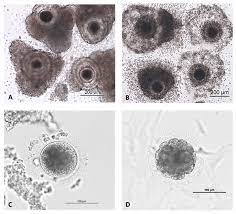Invitro-maturation, invitro-fertilization and embryo transfer (IVM) is a relatively new assisted reproductive technology (ART). IVM has been used as an alternative choice for ART for polycystic ovary syndrome (PCOS).
However, IVM is not the first choice of ART for PCOS patient yet, in spite of less risk of ovarian hyper stimulation syndrome (OHSS). The reason is not only because of relatively low pregnancy rate, but also poor recognition of IVM in fertility specialists.
In Japan, the first IVM pregnancy was achieved in 1999 and pregnancy from frozen thawed embryos derived from IVM in 2000. No known success cases are yet known in Nigeria.
Clinical and Laboratory Process for IVM Indications
Females with egg factor in which no mature eggs are found (germinal vesicle oocyt only), recurrent fertilization failure, or very poor quality embryos are also IVM targets. Patients who repeatedly failed IVF without distinct causes are IVM candidates, too.
Patient Pre-treatment
FSH and HCG Administration
FSH is usually administered from day 3 or 5 at dose of 150-300i.u. (FSH primary), the advantage of FSH priming can be described as easier follicular preparation. The efficacy of hCG administration 36 hours prior to that has been reported. Oocytes maturation rate is significantly improved by hCG priming.
The patients require monitoring and oocyte retrieval before further laboratory procedures of culturing.
Nuclear maturation process has been well investigated, but the mechanism of maturation in the cytoplasm remains unclear. Invitro oocyte maturation was observed using electron microscopy.
The mitochondria distribution was found to be homogenous in the germinal vesicles, but heterogenous in metaphase I and II. Mitochondria are found to be key factors for oocyte maturation.
DNA Probing
DNA probing is binding an agent directly to a predefined sequence of nucleic acids. A DNA microarray is a multiple technology used in molecular biology.
It consists of an arrayed series of thousands of microscopic spots of DNA oligonucleotides, called features each containing picomoles (10-12 moles) of a specific DNA sequence, known as probes (or reporters).
These can be a short section of a gene or other DNA element that are used to hybridize a CDNA or CRNA sample (called target) under high- stringency conditions.
Probe-target hybridization is usually detected and quantified by detection of flourophone-, silver-, or chemiluminescence-labelled targets to determine relative abundance of nucleic acid sequences in the target.
Read Also :
Since an array can contain tens of thousands of probes, a microarray experiment can accomplish many genetic tests in parallel. Therefore arrays have dramatically accelerated many types of investigation.
Nuclear Transfer
Nuclear transfer is a form of cloning. The steps involves removing the DNA from an oocyte (unfertilized egg), and injecting the nucleus which contains the DNA to be cloned.
In rare instances, the newly constructed cell will divide normally, replicating the new DNA while remaining in a pluripotent state.
Despite this, the low efficiency of the technique has prompted some researchers, notably Ian Wilmut, creator of Dolly, the cloned sheep, to abandon it.
Read Also : Induction and Synchronization of Oestrus and Ovulation; Multiple Ovulation and Embryo Transfer Technique
Tools and Reagents
Nuclear transfer is a delicate process that is a major hurdle in the development of cloning technology.

Materials used in this procedure are a microscope, a holding pipette (small vacuum) to keep the oocyte in place, and a micropipette (hair-thin needle) capable of extracting the nucleus of a cell using a vacuum.
For some species, such as mouse, a drill is used to pierce the outer layers of the oocyte.
Somatic Cell Nuclear Transfer
Somatic cell nuclear transfer (SCNT) or therapeutic cloning involves the nucleus of an unfertilized egg cell, replacing it with the material from the nucleus of a “somatic cell” (a skin, heart, or nerve cell, for example), and stimulating this cell to begin dividing.
Once the cell begins dividing, stem cells can be extracted 5-6 days later and used for research.
Genomic Reprogramming
Genomic reprogramming is the key biological process behind nuclear transfer. Currently, unidentified reprogramming factors present in oocytes are capable of initiating a cascade of events that can reset the mature, specialized cell back to an undifferentiated, embryonic state. These factors are thought to be mainly proteins of the nucleus.
In summary, Invitro-maturation, invitro-fertilization and embryo transfer are relatively new assisted reproductive technologies (ART).
DNA probing is binding an agent directly to a predefined sequence of nucleic acids, while nuclear transfer is a form of cloning. These technologies are used when there are medical indications requiring their employment.
Read Also : Household Waste Complete Management Guide
